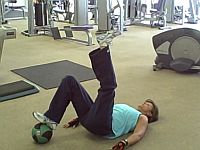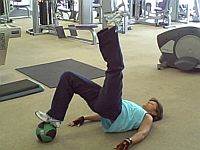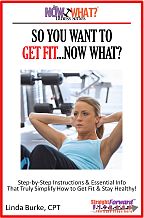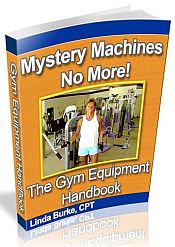|

|
| |
ARE YOU REACHING YOUR
TARGET HEART RATE?
Do you even know what that term means? Really? Well, if you don’t, you are not alone, I assure you. Recently, a friend requested I address it in my newsletter, and I aim to please...so, let’s just take a quick looksee at the issue and clear up any confusion that may lurk amongst the SFF readers. After all, it’s my mission to keep you guys in the know!
If walking is the cardio activity of your choosing, be it on a treadmill (TM) or in the great outdoors, you need to pay particular attention to trying to reach your target heart rate (THR).
The reason I distinguish walking from the rest of the viable
cardio modes
such as running, swimming, biking, elliptical machine, etc., is that it seems to be the easiest to nearly fall asleep doing. I’m sorry people, but I’ve actually seen some folks moving so slowly on the TM that they are no where near their target heart rate, never mind working up a sweat.
On the other hand, if you’ve ever hitched a ride on the elliptical express, you know it is impossible to NOT get your heart rate up on one of them. Those things are downright challenging. That’s why I LOVE EM!
But, I digress. I certainly do not mean to insinuate that you cannot get a good cardio workout on a treadmill or walking. Oh contraire! Read further to learn more about INTERVAL TRAINING. But first, more on the THR issue.
TARGET HEART RATE EXPLAINED
I am going to keep this simpler than simple. Here goes: Your target heart rate is the intensity (how fast or hard) you want or need to get your heart pumping in order to condition it or to achieve cardiovascular fitness.
What should that be, you ask? Well, studies show that optimum exercise intensity for fitness improvement is in the range of about 60% to 90% of maximum heart rate. Of course, the fitter you are, the higher the appropriate exercise intensity. Untrained individuals begin to improve at about 50% of max heart rate.
WHAT’S YOUR MAX HEART RATE?
Your maximum heart rate is figured by subtracting your age from 220. To figure your THR, you would then multiply that figure by your desired intensity. Let’s say you want to train at 70% of your max and you are 40 years old. 220 – 40 = 180. 180 x 70% = 126. That makes your THR about 21 beats for a 10-second count.
For a more in-depth discussion of this theory and to see a THR chart,
click here.
You should read that whole page while you are there.
It is important to note that the 220 minus age equation is meant to serve as a general guideline at best; there is a great deal of controversy over its accuracy.
Here's the problem: It overestimates the maximum rate in young adults, does a pretty good job for people who are around 40 years old, and then increasingly underestimates the maximum rate as people get older.
Be sure to use caution when using the 220 minus age theory and combine it with either
RPE or the talk test
and common sense when assessing your exercise intensity.
MORAL OF THE STORY
Don’t become one of the gym drones or walking zombies who can’t figure out why the weight just won’t come off. You should check your heart rate periodically whilst doing your cardio to see that you are in the proper range. You may do that by checking your pulse at one of two locations: the carotid artery on the side of your neck

or the radial artery on your wrist.

Interval Training Explained
As I mentioned earlier, this is a great way to shake up your cardio training. Interval training is alternating short bursts of intense movement with a short period of less intense activity. By alternating intensity, you’re training your heart to be stronger and more efficient. You get to work harder without having to increase the intensity of the entire workout.
For example, instead of walking for 30 minutes: Warm up for 5-10 minutes Then alternate walking 1 minute with jogging 1 minute (or however long you can handle). Alternate this out for the duration of the cardio session (about 7 or 8 intervals) and finally…
Cool down for 5-10 minutes at the end to total 30 minutes.
You’ll burn more calories in less time. All together now, let me hear a great big “Win-win!” That’s what I’m talking about!
Interval training can be done in a variety of ways. Again, you can click on
beginning cardio
for more details on this. A more intense version of it is also known as HIT or HIIT training. (High intensity training or high intensity interval training.) However, bear in mind that this method is not for beginners.
If running isn't your game, not to worry. You can do interval training in a myriad of ways. You can do it on the elliptical, bikes, treadmills, etc., by changing up the intensity.
THE BOTTOM LINE
Okay, so hopefully you are a bit clearer on what Target Heart Rate is and why you need to be concerned with it. If you are not working hard enough, you will not reap the benefits you are working for in the first place. If you are going to do this, why not do it right and make it count?
If you have any further questions or concerns about cardio training, HIT training, interval training, or target heart rate, please do not hesitate to
contact me.
I'll be more than happy to answer any questions and would love to hear from you!
EXERCISE OF THE MONTH
This is the part of the newsletter where I picture an exercise and give explicit instructions on its proper execution. This month’s exercise is great for the drop-butt syndrome that is plaguing many of us boomers out there. It's perfect for lifting the old booty back up where it belongs. I call it the 1-legged kickup.
It is an excellent exercise and another one of my favorites so be sure and give it a try. It's very difficult, so if you find your hamstring (back of upper leg) about to go into a cramp when you try it, you may want to cease and desist and do the modified version where you just do it with your foot on the floor instead of the ball!
1-LEGGED KICKUPS
Primary Muscle Group Worked: Glutimus Maximus (bootimus).
Secondary Muscle Groups Worked: Lower back, hamstrings, calves, abs.


Starting Position: Lie on your back with both knees bent and flat on the floor. Place a small medicine ball underneath your right foot, as shown.
Execution: While pressing your foot into the ball, lift your hips off the floor, driving the left leg straight up into the air as if you are trying to touch the ceiling with the bottom of your foot. Return to the start position and repeat for desired amount of reps. Switch to the other leg and repeat.
TIPS: Do not allow the hips to touch the floor between reps.
HEREIN LIES THE CHALLENGE: Keeping your balance on the ball is only half the fun. As I briefly mentioned before, many people experience a near-cramp situation in the exercising hamstring when first trying this. If this happens, stop and do the exercise without the ball. Just keep the foot flat on the floor instead and do the exercise as instructed. Trust me, your butt and hammies will still feel this work! After a few weeks of this, try doing it on the medicine ball again. Good luck!
THE PONDER POND
Okay, peeps! This is the inspirational part of the newsletter known as the "Ponder Pond" where you're welcome to take a swim in the sweet waters of inspiration that can only come from things that make you go, "Wow!"
If you are anything like me, this week's video will make you stop for a couple of minutes and smile and just plain feel good all over. Just go ahead and start now...all together,
Awwwwwwwwwwwwwww...
See, I told ya. Now, don't you just want to grab the closest 4-legged creature and squeeze it till it squeaks?!
Well, that's about it for this month! Until the next issue, may the wind be at your back and improved health and vitality your new reality!
If you enjoyed this newsletter, please feel free to pay it forward to anyone you think would like it too. That is the best compliment you could ever pay me, and I appreciate it very, very much.
And don't forget to tell everybody about.
Straightforwardfitness.com
where they can get all the free fitness info their heart desires and sign up for this newsletter while they are there.
From my heart to your health,
Linda Burke, CPT
|
|
Buy The Now What? Fitness Series Books Here!

Please go to
Amazon.com
or
Smashwords
to purchase any version your little ole' heart desires.
To Get a Free Copy of The Gym Equipment Handbook
and Much, Much More...Simply Click on the "Click Here" Button Above or Click on My Book Below and Enjoy All the Free Gifts on That Page That You Want!

Sign Up Below For Your Free Monthly Newsletter, The Straightforward Fitness Flash!
|









